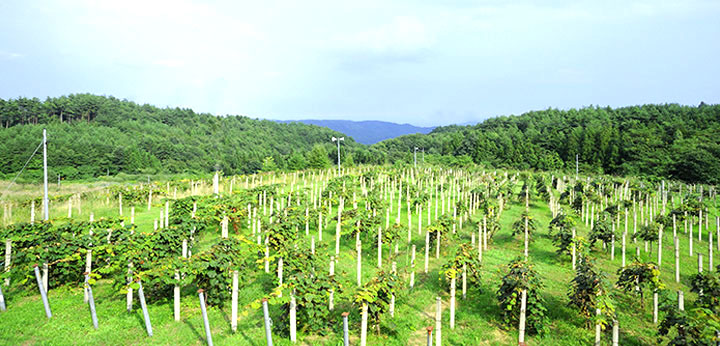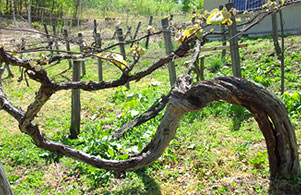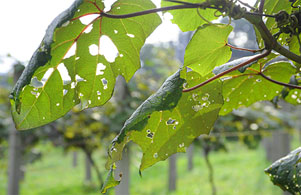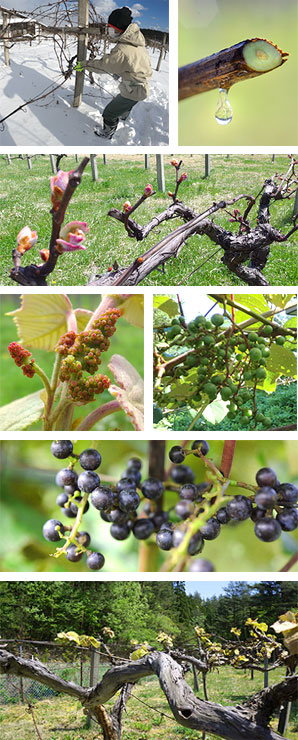▶ About Crimson glory vine
▶ Our Principles
▶ About Sakohonten
▶ About Company Vineyard
▶ How to Enjoy

For about half a century in the past since the opening
of the company’s vineyard, we have been sticking to a founder’s wish: To grow organic and chemical-free Crimson glory vines.
Company Vineyard Overview
Taking up a challenge to cultivate wild Crimson glory vines for the first time in Japan
In 1971, the same year as “Yama-no-Kibudo” was put on the market, the company opened its own vineyard in Ohkawame-cho, Kuji-shi, and launched the Japan’s first Crimson glory vine cultivation. Before this the founder had to buy Crimson glory vines as needed from his neighbor farmers who picked them in mountains. Wild Crimson glory vines bear fruit in every other year. The founder, foreseeing the shortage of wild vines, took up a challenge to solve this problem by creating his own 10 ha vineyard at a hill site, facing the Pacific Ocean and 450 m above the sea level. The site was originally cleared by newcomers after the Second World War.
Learning curve of each step of cultivation method
 At first the staff of the company had to go through a series of failures. Nobody in the company had specific knowledge on how to grow Crimson glory vines. After gathering branches of wild Crimson glory vines in surrounding mountains, self-rooting saplings were planted in the vineyard. These vines grew enough to flower 5 years later, but many of them failed to bear berries. In fact, at that time nobody in the company knew that Crimson glory vine was only heterothallic vine species in the grape family and that 70% of wild vines were male. Only 77 out of 2,000 vines planted in the 10 ha company vineyard were turned out to be female. They cultivated these 77 female plants for saplings so that the number of female vines would increase. It was fortunate that Crimson glory vine was a species of self-pollination and that, unlike kiwi, both male and female vines did not have to be nearby each other for fruiting.
At first the staff of the company had to go through a series of failures. Nobody in the company had specific knowledge on how to grow Crimson glory vines. After gathering branches of wild Crimson glory vines in surrounding mountains, self-rooting saplings were planted in the vineyard. These vines grew enough to flower 5 years later, but many of them failed to bear berries. In fact, at that time nobody in the company knew that Crimson glory vine was only heterothallic vine species in the grape family and that 70% of wild vines were male. Only 77 out of 2,000 vines planted in the 10 ha company vineyard were turned out to be female. They cultivated these 77 female plants for saplings so that the number of female vines would increase. It was fortunate that Crimson glory vine was a species of self-pollination and that, unlike kiwi, both male and female vines did not have to be nearby each other for fruiting.
As the 100th anniversary of the company vineyard approaches
In 1985 the vineyard area was expanded from 10 ha to 25 ha. We grow currently about 6,000 Crimson glory vines in these areas. We adopted two methods of cultivation: a Japanese horizontal trellis style in the original 10 ha section (Vineyard I) and an European vertical shoot positioning style in the expanded 15 ha section (Vineyard II). Both methods yield high-quality Crimson glory vines at consistent volumes. In the vineyard old 7 female vines, nicknamed “Seven Sisters,” which were planted at the time of the opening are still healthy and yield berries. These vines may live to witness the growth of other vines since the life expectancy of Crimson glory vine is said to be over 100 years.

Following the principles of cultivation
Chemical-free cultivation
 To keep the founder’s wish: “Ensure to grow safe and satisfactory Crimson glory vines,” we chose not to use agricultural chemicals from the very beginning even though in those days other vine growers generally used agrochemicals. In practice it was difficult to avoid damages caused by diseases and harmful insects without pesticides. All leaves were so damaged by a huge summer outbreak of lymantria dispar (gipsy moth) in each year from 2008 to 2010 that our Crimson glory vines could not yield any fruit at all for four years. Even under such a difficult condition, no chemicals were sprayed. In the company vineyard leaves of vines are still eaten by insects and weeds are growing underneath, proving that Crimson glory vines are cultivated under a chemical-free environment.
To keep the founder’s wish: “Ensure to grow safe and satisfactory Crimson glory vines,” we chose not to use agricultural chemicals from the very beginning even though in those days other vine growers generally used agrochemicals. In practice it was difficult to avoid damages caused by diseases and harmful insects without pesticides. All leaves were so damaged by a huge summer outbreak of lymantria dispar (gipsy moth) in each year from 2008 to 2010 that our Crimson glory vines could not yield any fruit at all for four years. Even under such a difficult condition, no chemicals were sprayed. In the company vineyard leaves of vines are still eaten by insects and weeds are growing underneath, proving that Crimson glory vines are cultivated under a chemical-free environment.
Organic cultivation that lets nature to take care of its cycle
 We have never used inorganic fertilizer in our vineyard since its opening. Crimson glory vine is originally a wild species which does not require much fertilizer. Sakohonten has been practicing a recycling-based cultivation, a method wherein marc (solid remains of grapes after pressing to make juice) is fermented and used as a fertilizer for the following year. Crimson glory vines are lightly heated for effective extraction of their ingredients. A properly heated marc can be well fermented and becomes an effective fertilizer. The fertilizer made from the marc of Crimson glory vines must have a high degree of affinity with vines being cultivated. Sakohonten is the only business establishment that has kept the chemical-free organic cultivation of Crimson glory vines among other growers in Japan.
We have never used inorganic fertilizer in our vineyard since its opening. Crimson glory vine is originally a wild species which does not require much fertilizer. Sakohonten has been practicing a recycling-based cultivation, a method wherein marc (solid remains of grapes after pressing to make juice) is fermented and used as a fertilizer for the following year. Crimson glory vines are lightly heated for effective extraction of their ingredients. A properly heated marc can be well fermented and becomes an effective fertilizer. The fertilizer made from the marc of Crimson glory vines must have a high degree of affinity with vines being cultivated. Sakohonten is the only business establishment that has kept the chemical-free organic cultivation of Crimson glory vines among other growers in Japan.
Grapevine maintenance practiced all year round:
Crimson glory vine, a natural wonder adapted to the severe environment in the northern Tohoku region. Having overcome “Yamase,” a great enemy during the blooming time, the vines go through the blessings of sunshine in summer. All they do now is to wait for the approaching harvest season.
Pruning (January – February)
The annual operation of the vineyard starts with pruning in the dormant period. Pruning is done based on the health of each vine in the previous year and on the planned level of harvest volume.
Sap harvesting (April)
April has been a month for sap gathering since 2013. Since the sap can be harvested once a year for only 2 weeks in April, we sometimes work even in snowfall racing with time.
Budburst (late April)
This is the time when buds on the vines start swelling and their new pink leaves begin opening. The vineyard gets brightened and vivid as if all flowers were in full bloom. Sour-sweet aroma fills the entire vineyard, predicting a rich harvest in autumn.
Flowering (late May – early June)
Female vines start blooming. The corolla of a flower falls off after self-pollination and the ovary containing seeds becomes a tiny fruit. This is the most important stage for flower buds to be exposed to the sun under a temperate climate. The vines must overcome powerful enemies: Yamase (cold Pacific winds characteristic of the Kuji area) and late frost.
Fruit growth period (June – August)
If the climate in the flowering season is mild enough for fruits to form and achieve healthy growth, then the berries suck up much nutrient from the ground and become larger.
Coloring season (late August – September)
The vines grown to the stage as described above start changing colors. A bunch of grapes needs about 10 leaves for proper photosynthesis. Fewer numbers will cause inadequate photosynthesis resulting in insufficient coloring.
Harvesting (mid-September – mid-October)
Harvesting starts across the vineyard. Those vines with a light acidity used for making “Yama-no-Kibudo,” jam and puree are harvested by the end of September. Vines for “Kanjuku Yama-no-Kibudo” are harvested in October when their fruits become completely ripe.
Leaves falling (November – December)
When the harvest season comes to an end, vines can finally rest for the coming year. Vine sap goes down to the roots for wintering causing leaves to fall. Vines go dormant for the winter’s rest.

Sakohonten Co., Ltd.
Products
Beverage Products
Cosmetic Raw Materials
About Us
Copyright © 2023 Sakohonten Co., Ltd. All rights reserved.
